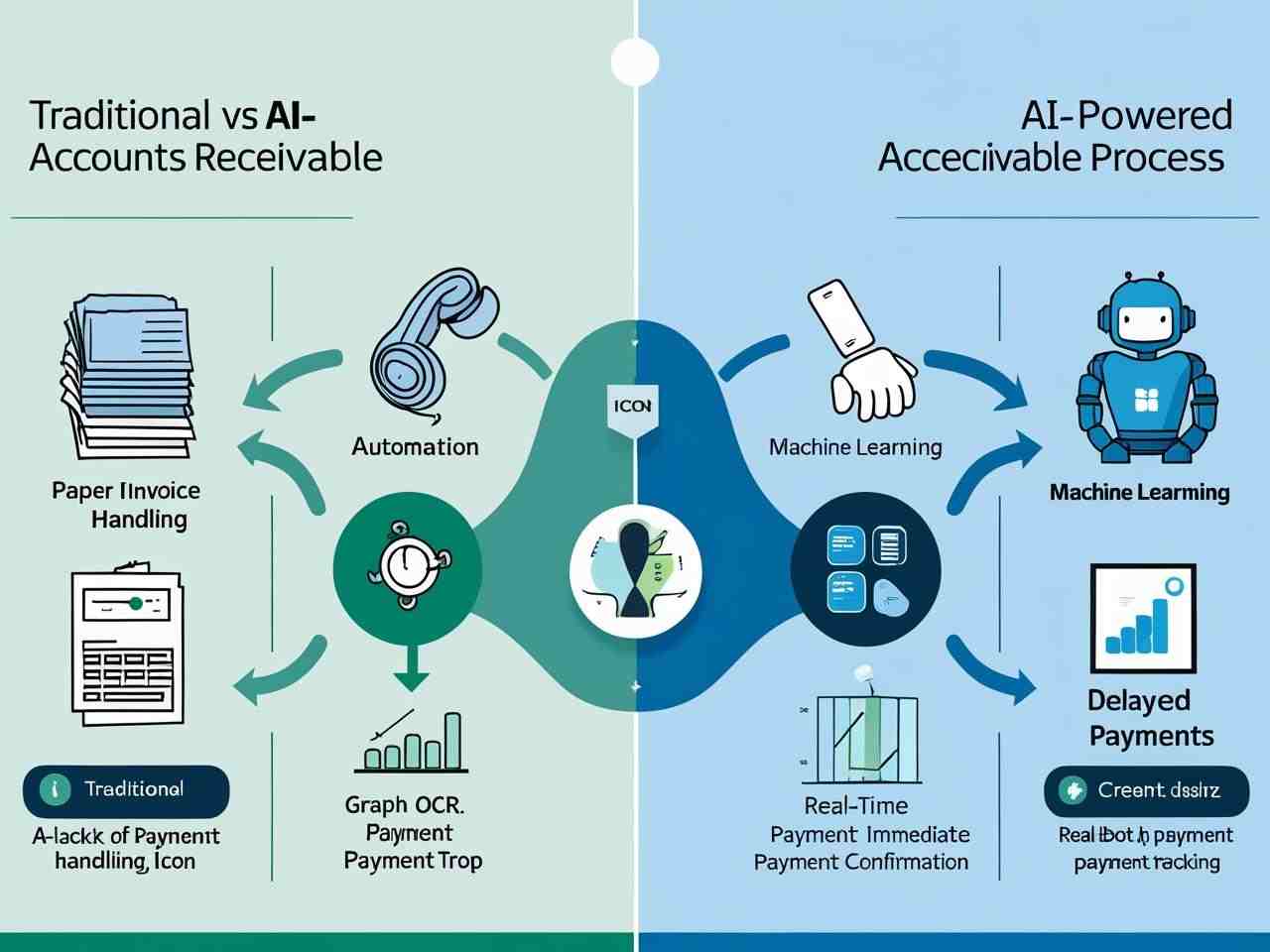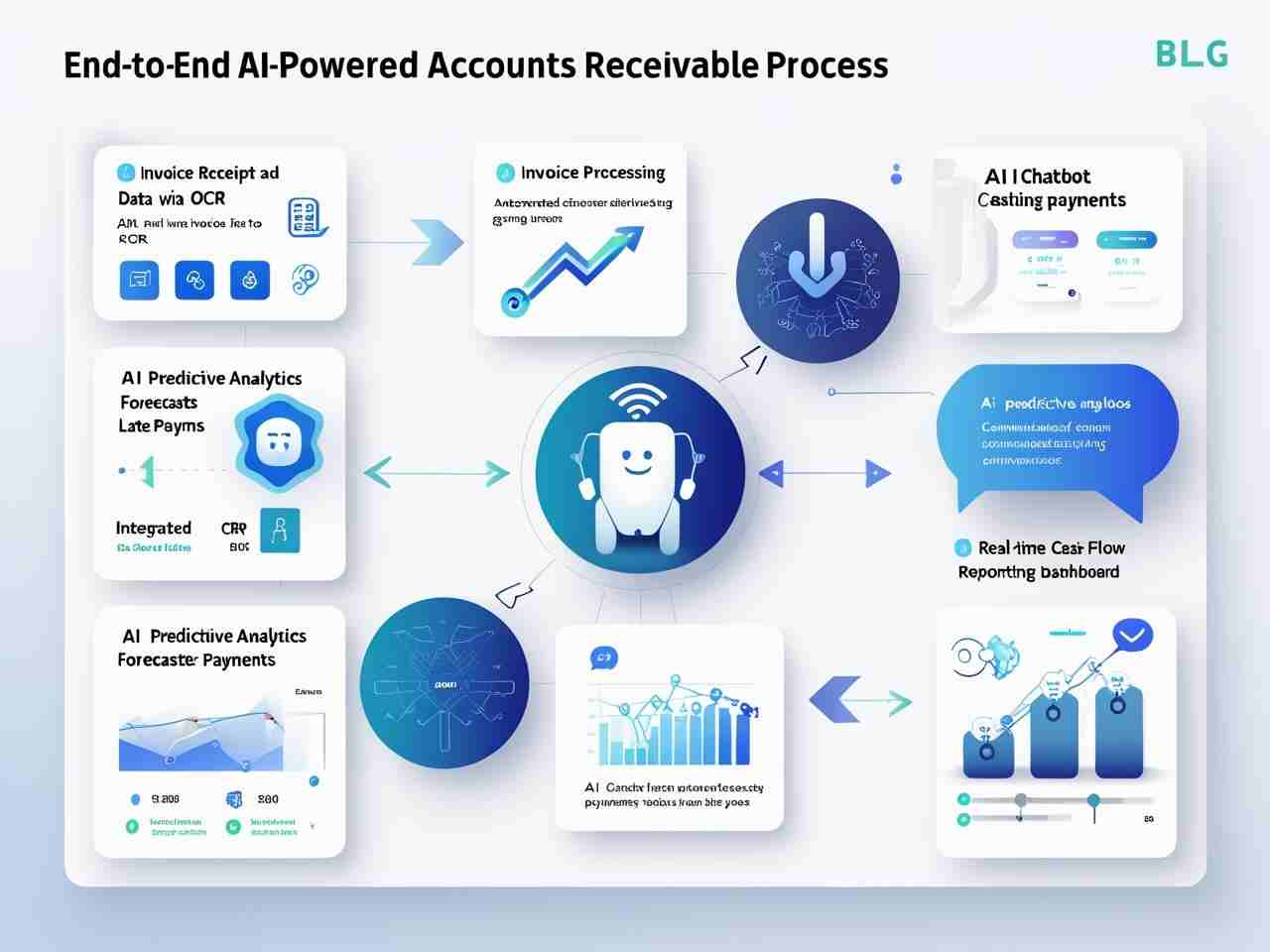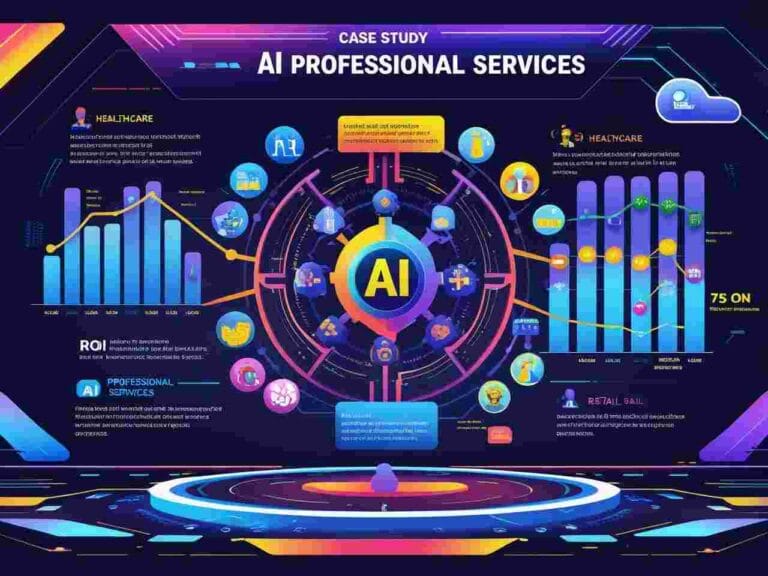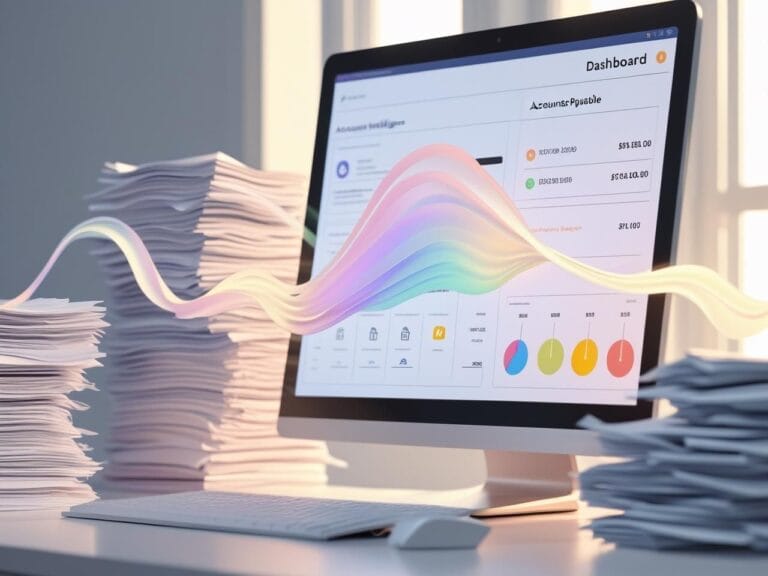6 Powerful Benefits of Artificial Intelligence in Accounts Receivable
Introduction
If you’re still relying on spreadsheets and manual follow-ups to manage your accounts receivable, you’re not just behind—you’re bleeding time and money. The truth is, Artificial Intelligence in Accounts Receivable is no longer a futuristic idea. It’s here, and it’s quietly revolutionizing how businesses get paid.
Imagine a system that not only tracks your outstanding invoices but also predicts when a client is likely to pay late—and follows up before the problem even begins. That’s the power of AI in AR. It combines smart algorithms, data analytics, and machine learning to help finance teams automate routine tasks, reduce errors, and recover cash faster.
In a world where cash flow is king and financial efficiency defines survival, AI isn’t just a helpful tool—it’s becoming essential. For modern finance teams, artificial intelligence in accounts receivable means more time to focus on strategy, less time chasing payments, and more confidence in financial forecasting.
Let’s break down exactly how it works and why every business—no matter the size—needs to pay attention.
What is Artificial Intelligence in Accounts Receivable?
Basic Definition of AI in Finance
At its core, Artificial Intelligence is a type of computer intelligence that can “learn” from data, make decisions, and perform tasks that normally require human thinking. In the world of finance—especially in accounts receivable—AI becomes your silent partner that never sleeps, forgets, or takes a break.
Think of AI as a super-smart assistant that reviews thousands of invoices, tracks payment patterns, and automatically follows up with clients—all without a single sigh or cup of coffee. It’s made possible by machine learning (ML), natural language processing (NLP), and automation technologies.
- Machine learning helps AI spot patterns in how and when customers pay, so it can predict future behavior.
- NLP allows AI systems to read and respond to emails, invoices, or even customer queries like a human would.
- Automation means no more manual data entry, no more missed follow-ups, and no more human error.
Here’s a simple analogy: Traditional AR is like mailing out bills by horse-drawn carriage and waiting weeks for a reply. AI-powered AR is more like using a high-speed drone that sends, tracks, and even negotiates invoices instantly.

This evolution is giving finance teams more control, deeper insights, and faster payments—all while lightening the workload.
Core Components of AI in AR
The magic of Artificial Intelligence in Accounts Receivable lies in how it brings multiple smart technologies together to handle everyday tasks—faster, better, and with fewer mistakes. Let’s break down the core components that are transforming how companies collect money.
1. Smart Data Extraction
No more manually typing in invoice numbers or customer names. AI tools can scan emails, PDFs, and spreadsheets to automatically pull out relevant financial data with near-perfect accuracy. Think of it as a pair of digital eyes that never miss a detail.
2. Invoice Automation
Once the data is extracted, AI takes over the entire invoicing process—from creation to delivery to follow-up. It knows when to send reminders, escalate late payments, and even adjust timing based on a customer’s past behavior.
3. Predictive Analytics
AI doesn’t just react—it predicts. Based on historical payment patterns, it can forecast which invoices are likely to be paid late, how much cash will come in next week, or which clients need closer attention.
4. NLP-Based Communication
Using Natural Language Processing (NLP), AI can draft and send human-like emails, respond to customer queries, or escalate payment notices with tact. It’s like having a polite, consistent virtual collector working 24/7.
Table Below: “Manual vs AI-Driven AR Tasks”
| Task | Manual AR | AI-Driven AR |
| Data Entry | Time-consuming & error-prone | Automated & accurate |
| Invoice Generation | Manually created & sent | Fully automated workflows |
| Payment Reminders | Sent manually | Scheduled based on customer habits |
| Forecasting Cash Flow | Based on gut feeling/spreadsheets | Data-driven predictions |
| Customer Follow-ups | Human-written emails | NLP-powered, human-like messages |
These components work together to help businesses streamline collections, reduce delays, and ultimately—get paid faster.
How Is AI Used in Accounts Receivable?
Artificial Intelligence in Accounts Receivable isn’t just a buzzword—it’s actively reshaping how finance teams operate behind the scenes. From invoice creation to follow-ups and forecasting, AI brings automation, intelligence, and speed into a process that used to be slow, manual, and error-prone. Let’s explore how exactly AI is being used in the real world.
Automation of Invoice Processing
One of the most time-consuming tasks in AR is handling invoices. AI uses Optical Character Recognition (OCR) and smart data extraction to read documents like invoices, purchase orders, and receipts—even if they’re scanned or handwritten.
Once the data is captured, AI systems can automatically generate invoices, assign them to the right clients, and send them via email. But it doesn’t stop there. AI also tracks each invoice’s status, sends reminders as due dates approach, and even escalates follow-ups when payments are overdue. It’s like having an invisible assistant handling it all—accurately and on time.
Predictive Analytics & Payment Forecasting
What if you could predict who’s going to pay late—before it even happens? That’s exactly what AI does through predictive analytics. It learns from past payment patterns, customer behavior, and industry trends to forecast delays, calculate risk scores, and offer realistic cash flow projections.
For CFOs and AR managers, this means better planning, fewer surprises, and more strategic decisions around credit limits and collection timelines. AI turns reactive finance into proactive finance.
AI Chatbots for Collections
Collections can be awkward. But AI-powered chatbots take the emotion out of the process while keeping communication polite and professional. Using Natural Language Processing (NLP), these bots can send personalized reminders via email or SMS, respond to customer queries, and even negotiate partial payments—without ever sounding robotic.
And unlike humans, AI bots don’t forget to follow up. They maintain consistency, which is crucial in recovering overdue funds while preserving client relationships.
Integration with ERPs & CRMs
To work effectively, AI in AR must talk to other systems. That’s why modern AI tools seamlessly integrate with ERP and CRM platforms like QuickBooks, NetSuite, SAP, Salesforce, and more. These integrations allow for real-time updates, ensure all financial data is synced, and eliminate the need to copy-paste data across multiple platforms.

This connected, intelligent system helps companies stay agile, informed, and always a step ahead when it comes to managing their receivables.
What Are the Benefits of AI in Accounts Receivable?
Implementing Artificial Intelligence in Accounts Receivable isn’t just about catching up with technology—it’s about unlocking real, measurable benefits that impact your bottom line and your peace of mind. Let’s take a closer look at how AI transforms AR from a routine back-office function into a revenue-driving machine.
1. Reduced DSO (Days Sales Outstanding)
AI helps businesses get paid faster. By automating follow-ups and predicting late payments, companies can significantly reduce DSO, meaning cash hits the bank sooner. That’s money you can reinvest in growth, payroll, or new opportunities—without borrowing.
2. Better Cash Flow Visibility
AI-powered dashboards and forecasting tools provide real-time insights into how much cash is coming in and when. No more guesswork or digging through spreadsheets. Just clear, accurate data you can trust to make smarter decisions.
3. Lower Administrative Costs
Manual AR processes are expensive. Data entry, invoice prep, and customer follow-ups eat up hours of employee time. With AI, these tasks are automated, freeing your team to focus on higher-value work like strategy, customer engagement, and business development.
4. Improved Customer Relationships
Surprisingly, automation can make your business feel more human. With AI-driven personalization, follow-up messages are timely, polite, and consistent. Customers feel respected, not hounded—leading to better relationships and more repeat business.
5. Fewer Human Errors
AI doesn’t get tired, distracted, or overwhelmed. That means fewer mistakes, like billing the wrong client or missing a follow-up. Accuracy builds trust—and protects your reputation.
6. Real-Time Decision-Making
With everything happening live—payments, communications, risks—finance leaders can make decisions in the moment, backed by real-time data and predictive insights.
Table Below: ROI Comparison – Manual vs AI-Driven AR System
| Metric | Manual AR System | AI-Powered AR System |
| Average DSO | 45–60 days | 25–35 days |
| Admin Hours per Week | 20–30 hours | 5–10 hours |
| Payment Collection Rate | ~85% | 95%+ |
| Error Rate (Invoice & Follow-up) | High | Very Low |
| Monthly AR Cost | Higher (due to labor/time) | Lower (automation-based ROI) |
By embracing AI in accounts receivable, businesses are not just keeping up—they’re getting ahead.
What Is Generative AI in Accounts Receivable?
In the evolving world of Artificial Intelligence in Accounts Receivable, a newer, more creative type of AI is stepping into the spotlight—Generative AI. While traditional AI focuses on automation and prediction, generative AI takes it one step further by actually creating content, messages, and insights tailored to individual customer behavior.
How Generative AI Differs from Traditional AI
Traditional AI is like a sharp analyst—it processes large volumes of data, finds patterns, and makes decisions based on rules and history. Generative AI, on the other hand, acts more like a creative strategist. It uses advanced models like GPT (Generative Pre-trained Transformer) to write human-like messages, adapt tone, and personalize communication in real time.
For example, instead of sending a generic “Your payment is overdue” email, generative AI can craft a friendly, professional message tailored to a client’s history:
“Hi Sarah, we noticed your invoice #1052 from July 12 is still pending. You’ve always been prompt in the past, so we just wanted to check if you need a copy of the invoice or help with payment details.”
This kind of adaptive, human-like messaging improves response rates and preserves client relationships.
Use Cases of Generative AI in AR
Generative AI is finding its way into several valuable AR functions:
- Drafting Personalized Payment Reminders
No more one-size-fits-all emails. Generative AI creates custom reminders based on client tone preferences, language, and payment behavior. - Predicting Customer Responses
AI can simulate how likely a client is to respond to different messages, helping you choose the most effective communication strategy. - Generating Performance Reports
Generative AI can create narrative-driven AR reports that explain what’s happening in your receivables—without needing a finance degree to understand them.

As this technology matures, it’s not just helping companies collect faster—it’s helping them communicate better, forecast smarter, and build stronger customer trust.
Will AI Replace Accounts Receivable Jobs?
The rise of Artificial Intelligence in Accounts Receivable often sparks one big question: Will AI take over AR jobs completely? The short answer is no—at least, not the way many fear. Instead, AI is here to augment human roles, making us work smarter, not obsolete.
Augmentation, Not Replacement
AI excels at handling repetitive, time-consuming tasks like data entry, invoice processing, and sending reminders. These are the parts of AR work that most people find tedious. By automating them, AI frees finance professionals from grunt work so they can focus on exceptions, problem-solving, and strategic decision-making—areas where human judgment and emotional intelligence remain essential.
Think of AI as a reliable teammate who handles the routine, so you can focus on the creative and complex parts of your job.
New Roles Emerging in AR
With AI doing the heavy lifting, new career paths are opening up in AR departments:
- AR Data Analysts who interpret AI-driven insights to optimize collections and cash flow strategies.
- AI System Managers who oversee and fine-tune AI tools, ensuring they work accurately and ethically.
These roles require a mix of financial knowledge and tech skills, offering exciting opportunities for professionals ready to adapt.
Ethical and Practical Considerations
As AI systems make more decisions, transparency becomes crucial. Finance teams must understand how AI reaches conclusions—especially when it comes to collections, where tone and timing affect customer relationships.
That’s why human oversight remains non-negotiable. Teams must balance AI efficiency with empathy and ethical judgment to maintain trust and compliance.
Table Below: “Tasks AI Can vs Cannot Do in AR”
| Tasks AI Can Do | Tasks AI Cannot Do |
| Automate invoice data entry | Handle complex customer disputes |
| Send timely payment reminders | Make strategic credit decisions |
| Predict late payments | Build personal customer relationships |
| Generate performance reports | Understand nuanced financial ethics |
In summary, AI will reshape AR jobs but won’t replace the human touch that makes finance a dynamic and people-centered field.
Frequently Asked Questions
How does AI improve cash flow in AR?
AI helps improve cash flow by forecasting which payments might be late and prioritizing those accounts for follow-up. It automates reminders and escalations, ensuring invoices get attention at the right time. This proactive approach speeds up collections and reduces the time money sits unpaid.
Can AI reduce bad debts?
Absolutely. AI’s predictive models analyze past payment behavior and flag accounts that are likely to default or pay late. This early warning lets finance teams act quickly—whether by tightening credit, offering payment plans, or increasing communication—to reduce bad debts before they grow.
What software uses AI for AR?
There are several powerful AI-driven AR software tools available today. Some of the leading names include Tesorio, HighRadius, Versapay, Upflow, and YayPay. These platforms combine automation, predictive analytics, and smart communication features tailored for accounts receivable management.
How secure is AI in financial processes?
Security is a top priority. Most AI solutions for AR comply with industry standards such as GDPR and SOC 2 to protect sensitive financial data. However, it’s crucial for businesses to thoroughly vet their AI vendors, ensuring encryption, data privacy policies, and regular security audits are in place.
Conclusion
Adopting Artificial Intelligence in Accounts Receivable is no longer a luxury—it’s a game-changer. From reducing day sales outstanding and cutting administrative costs to improving cash flow visibility and enhancing customer relationships, AI brings undeniable benefits to every finance team.
But the real power lies in the collaboration between humans and AI. While machines handle repetitive tasks and data crunching, human expertise guides strategy, empathy, and decision-making. Together, they create an unstoppable force for smarter, faster, and more effective AR management.
Ready to explore: 4 Easy Steps to Use Muke AI: Free AI Writing Tool Guide






